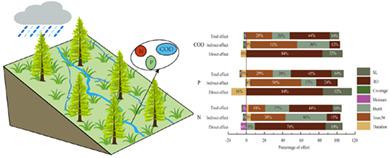当前位置:
X-MOL 学术
›
Hydrol. Process.
›
论文详情
Our official English website, www.x-mol.net, welcomes your
feedback! (Note: you will need to create a separate account there.)
Direct and indirect effects of rainfall and vegetation coverage on runoff, soil loss, and nutrient loss in a semi‐humid climate
Hydrological Processes ( IF 2.8 ) Pub Date : 2020-11-20 , DOI: 10.1002/hyp.13985 Jiayi Huo 1, 2 , Changjun Liu 1 , Xinxiao Yu 2 , Lihua Chen 2 , Wenge Zheng 3 , Yuanhui Yang 3 , Changwen Yin 4
Hydrological Processes ( IF 2.8 ) Pub Date : 2020-11-20 , DOI: 10.1002/hyp.13985 Jiayi Huo 1, 2 , Changjun Liu 1 , Xinxiao Yu 2 , Lihua Chen 2 , Wenge Zheng 3 , Yuanhui Yang 3 , Changwen Yin 4
Affiliation

|
Soil and nutrient loss play a vital role in eutrophication of water bodies. Several simulated rainfall experiments have been conducted to investigate the effects of a single controlling factor on soil and nutrient loss. However, the role of precipitation and vegetation coverage in quantifying soil and nutrient loss is still unclear. We monitored runoff, soil loss, and soil nutrient loss under natural rainfall conditions from 2004 to 2015 for 50–100 m2 runoff plots around Beijing. Results showed that soil erosion was significantly reduced when vegetation coverage reached 20% and 60%. At levels below 30%, nutrient loss did not differ among different vegetation cover levels. Minimum soil N and P losses were observed at cover levels above 60%. Irrespective of the management measure, soil nutrient losses were higher at high‐intensity rainfall (Imax30>15 mm/h) events compared to low‐intensity events (p < 0.05). We applied structural equation modelling (SEM) to systematically analyze the relative effects of rainfall characteristics and environmental factors on runoff, soil loss, and soil nutrient loss. At high‐intensity rainfall events, neither vegetation cover nor antecedent soil moisture content (ASMC) affected runoff and soil loss. After log‐transformation, soil nutrient loss was significantly linearly correlated with runoff and soil loss (p < 0.01). In addition, we identified the direct and indirect relationships among the influencing factors of soil nutrient loss on runoff plots and constructed a structural diagram of these relationships. The factors positively impacting soil nutrient loss were runoff (44%–48%), maximum rainfall intensity over a 30‐min period (18%–29%), rainfall depth (20%–27%), and soil loss (10%–14%). Studying the effects of rainfall and vegetation coverage factors on runoff, soil loss, and nutrient loss can improve our understanding of the underlying mechanism of slope non‐point source pollution.
更新日期:2021-01-19









































 京公网安备 11010802027423号
京公网安备 11010802027423号